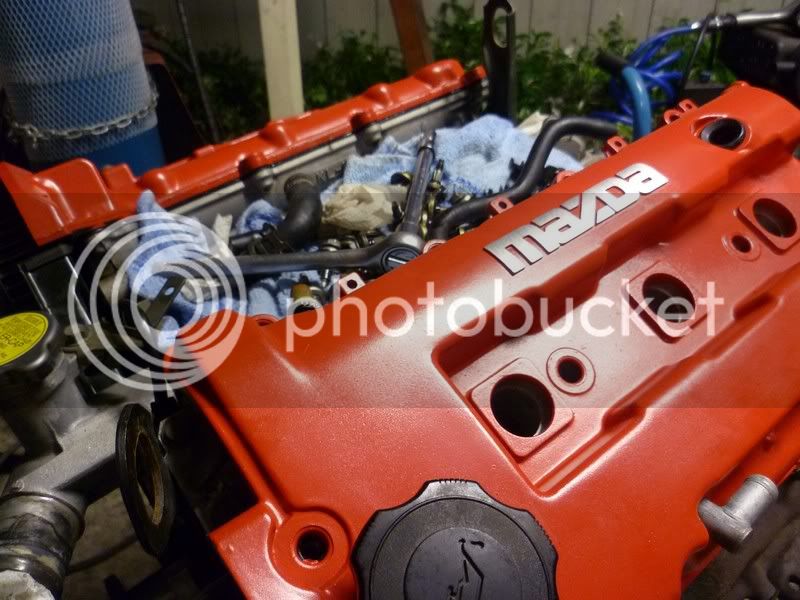The model's rocker cover is pretty similar to the drawn steel original but was machined from a block of 6061 aluminum. A significant difference between them is the original cover attached to the head with seven hex bolts around its perimeter, while the model's cover will be held down with three centrally located studs.
I'd been looking forward to the rocker cover because it was a perfect opportunity to use a new-to-me engraving operation in my CAM software. I've engraved lots of parts using a general purpose 2-d contouring operation to guide a v-cutter over simple stroke fonts. But Sprutcam has a dedicated operation capable of raising or lowering any Windows font using a variety of wall styles.
I hoped to machine the 'powered by Ford' logo that I remembered being in the top of my project truck's rocker cover. But after spending hours working around the cover's filler cap and mounting holes with different fonts, sizes, and spacings, I settled on just 'Ford'.
After a few practice engravings, the cover's exterior machining was pretty straight forward, although its curvy exterior left me with a work-holding problem for the machining of its interior. A wood form, band-sawed with a matching contour, helped spread the clamping forces over the cover's thin (.063") walls. Internal notches were added to the starboard inside edge for additional clearance to the ends of the rocker arms. A pair of 3/64" dowel pins were also added to the head to positively locate the cover.
The cover was painted with Gun Kote's metallic blue - a shade somewhere in between Ford's light and dark blues. Gun Kote is a durable bake-on (325F) resin-based coating that's resistant to gas, oil, and most solvents around my shop. I've used it on small areas on some of my other model engines. With a typical air brushed thickness less than .0005", it typically isn't necessary to mask off tapped holes (except spark plug bores). I only recently discovered the Kote has become available in colors other than black, gray and drab olive.
I originally planned to paint only the rocker cover and then bead blast it away if I didn't like the result. After a few days I was still happy with the cover, and the novelty of a realistically colored engine grew on me, and so I painted the whole thing. - Terry










I'd been looking forward to the rocker cover because it was a perfect opportunity to use a new-to-me engraving operation in my CAM software. I've engraved lots of parts using a general purpose 2-d contouring operation to guide a v-cutter over simple stroke fonts. But Sprutcam has a dedicated operation capable of raising or lowering any Windows font using a variety of wall styles.
I hoped to machine the 'powered by Ford' logo that I remembered being in the top of my project truck's rocker cover. But after spending hours working around the cover's filler cap and mounting holes with different fonts, sizes, and spacings, I settled on just 'Ford'.
After a few practice engravings, the cover's exterior machining was pretty straight forward, although its curvy exterior left me with a work-holding problem for the machining of its interior. A wood form, band-sawed with a matching contour, helped spread the clamping forces over the cover's thin (.063") walls. Internal notches were added to the starboard inside edge for additional clearance to the ends of the rocker arms. A pair of 3/64" dowel pins were also added to the head to positively locate the cover.
The cover was painted with Gun Kote's metallic blue - a shade somewhere in between Ford's light and dark blues. Gun Kote is a durable bake-on (325F) resin-based coating that's resistant to gas, oil, and most solvents around my shop. I've used it on small areas on some of my other model engines. With a typical air brushed thickness less than .0005", it typically isn't necessary to mask off tapped holes (except spark plug bores). I only recently discovered the Kote has become available in colors other than black, gray and drab olive.
I originally planned to paint only the rocker cover and then bead blast it away if I didn't like the result. After a few days I was still happy with the cover, and the novelty of a realistically colored engine grew on me, and so I painted the whole thing. - Terry





























































![DreamPlan Home Design and Landscaping Software Free for Windows [PC Download]](https://m.media-amazon.com/images/I/51kvZH2dVLL._SL500_.jpg)









![Learning AutoCAD Civil 3D 2014 [Online Code]](https://m.media-amazon.com/images/I/51F3yi9fokL._SL500_.jpg)







































